Investigation of Aerosol Climatology and Long-Range Transport of Aerosols over Pokhara, Nepal
Abstract
1. Introduction
2. Methodology
2.1. Site Description
2.2. Cimel Sun Photometer
2.3. Basic Equations and Definitions
2.4. Tools Used for Backward Trajectories and Fire Spots
3. Results and Discussion
3.1. Variability of Spectral Columnar AOD and Precipitable Water
3.2. Angstrom Exponents, Curvature of AOD Spectra, SSA, AAOD and AAE
3.3. Investigation of Aerosol Sources and Types
4. Conclusions
Author Contributions
Funding
Acknowledgments
Conflicts of Interest
References
- Myhre, G.; Berglen, T.F.; Johnsrud, M.; Hoyle, C.R.; Berntsen, T.K.; Christopher, S.A.; Fahey, D.W.; Isaksen, I.S.A.; Jones, T.A.; Kahn, R.A.; et al. Modelled radiative forcing of the direct aerosol effect with multi-observation evaluation. Atmos. Chem. Phys. 2009, 9, 1365–1392. [Google Scholar] [CrossRef]
- Bergstrom, R.W.; Pilewskie, P.; Russell, P.B.; Redemann, J.; Bond, T.C.; Quinn, P.K.; Sierau, B. Spectral absorption properties of atmospheric aerosols. Atmos. Chem. Phys. 2007, 7, 5937–5943. [Google Scholar] [CrossRef]
- Russell, P.B.; Bergstrom, R.W.; Shinozuka, Y.; Clarke, A.D.; DeCarlo, P.F.; Jimenez, J.L.; Livingston, J.M.; Redemann, J.; Dubovik, O.; Strawa, A. Absorption Angstrom Exponent in AERONET and related data as an indicator of aerosol composition. Atmos. Chem. Phys. 2010, 10, 1155–1169. [Google Scholar] [CrossRef]
- Li, C.; Chen, P.; Kang, S.; Yan, F.; Tripathee, L.; Wu, G.; Qu, B.; Sillanpää, M.; Yang, D.; Dittmar, T.; et al. Fossil fuel combustion emission from South Asia influences precipitation dissolved organic carbon reaching the remote Tibetan plateau: Isotopic and molecular evidence. J. Geophys. Res. Atmos. 2018, 123, 6248–6258. [Google Scholar] [CrossRef]
- Dhungel, S.; Kathayat, B.; Mahata, K.; Panday, A. Transport of regional pollutants through a remote trans-Himalayan valley in Nepal. Atmos. Chem. Phys. 2018, 18, 1203–1216. [Google Scholar] [CrossRef]
- Xu, B.; Cao, J.; Hansen, J.; Yao, T.; Joswia, D.R.; Wang, N.; Wu, G.; Wang, M.; Zhao, H.; Yang, W.; et al. Black soot and the survival of Tibetan glaciers. Proc. Natl. Acad. Sci. USA 2010, 106, 22114–22118. [Google Scholar] [CrossRef]
- Li, C.; Bosch, C.; Kang, S.; Andersson, A.; Chen, P.; Zhang, Q.; Cong, Z.; Bing, C.; Qin, D.; Gustafsson, Ö. Sources of black carbon to the Himalayan–Tibetan Plateau glaciers. Nat. Commun. 2016, 7, 12574. [Google Scholar] [CrossRef]
- Zhang, R.; Wang, H.; Qian, Y.; Rasch, P.J.; Easter, R.C.; Ma, P.L.; Singh, B.; Huang, J. Quantifying sources, transport, deposition, and radiative forcing of black carbon over the Himalayas and Tibetan Plateau. Atmos. Chem. Phys. 2015, 15, 77–121. [Google Scholar] [CrossRef]
- Singh, A.; Mahata, K.S.; Rupakheti, M.; Junkermann, W.; Panday, A.K. An overview of airborne measurement in Nepal–Part 1: Vertical profile of aerosol size, number, spectral absorption, and meteorology. Atmos. Chem. Phys. 2019, 19, 245–258. [Google Scholar] [CrossRef]
- Kaskaoutis, D.G.; Sifakis, N.; Retalis, A.; Kambezidis, H.D. Aerosol monitoring over athens using satellite and ground-based measurements. Adv. Meteorol. 2010, 12. [Google Scholar] [CrossRef]
- Aryal, R.P.; Voss, K.J.; Terman, P.A.; Keene, W.C.; Moody, J.L.; Welton, E.J.; Holben, B.N. Comparison of surface and column measurements of aerosol scattering properties over the western North Atlantic Ocean at Bermuda. Atmos. Chem. Phys. 2014, 14, 7617–7629. [Google Scholar] [CrossRef]
- Holben, B.; Eck, T.; Slutsker, I.; Tanre, D.; Buis, J.; Setzer, A.; Vermote, E.; Reagan, J.; Kaufman, Y.; Nakajima, T.; et al. AERONET—A federated instrument network and data archive for aerosol characterization. Remote Sens. Environ. 1998, 66, 1–16. [Google Scholar] [CrossRef]
- Stein, A.F.; Draxler, R.R.; Rolph, G.D.; Stunder, B.J.B.; Cohen, M.D.; Ngan, F. NOAA’s HYSPLIT atmospheric transport and dispersion modeling system. Bull. Am. Meteor. Soc. 2015, 96, 2059–2077. [Google Scholar] [CrossRef]
- Holben, B.; Tanre, D.; Smirnov, A.; Eck, T.; Slutsker, I.; Abuhassan, N.; Newcomb, W.; Schafer, J.; Chatenet, B.; Lavenu, F.; et al. An emerging ground-based aerosol climatology: Aerosol optical depth from AERONET. J. Geophys. Res. 2001, 106, 12067–12097. [Google Scholar] [CrossRef]
- AERONET. Available online: http://aeronet.gsfc.nasa.gov/ (accessed on 1 April 2015).
- Dubovik, O.; King, M.A. Flexible inversion algorithm for retrieval of aerosol optical properties from sun and sky radiance measurements. J. Geophys. Res. 2000, 105, 20673–20696. [Google Scholar] [CrossRef]
- Eck, T.F.; Holben, B.N.; Reid, J.S.; Dubovik, O.; Smirnov, A.; O’ Neill, N.T.; Slutsker, I.; Kinne, S. Wavelength Dependence of the Optical Dept of Bio Mass Burning, Urban, and Desert Dust Aerosols. J. Geophys. Res. 1999, 104, 31333–31349. [Google Scholar] [CrossRef]
- Schuster, G.L.; Dubovik, O.; Holben, B.N. Ångström exponent and bimodal aerosol size distributions. J. Geophys. Res. Atmos. 2006, 111, 1–14. [Google Scholar] [CrossRef]
- Kaskaoutis, D.G.; Kambezidis, H.D.; Hatzianastassiou, N.; Kosmopoulos, P.G.; Badarinath, K.V.S. Aerosol climatology: Dependence of the Angstrom exponent on wavelength over four AERONET sites. Atmos. Chem. Phys. Discuss. 2007, 7, 7347–7397. [Google Scholar] [CrossRef]
- Holben, B.; Eck, T.; Slutsker, I.; Smirnov, A.; Schafer, J.; Giles, D.; Dubovik, O. AERONET’s Version 2.0 quality assurance criteria. Proc. SPIE 2006, 6408, 64080Q. [Google Scholar]
- Giles, D.M.; Sinyuk, M.S.; Sorokin, J.S.; Schafer, A.; Smirnov, I.; Slutsker, T.F.; Eck, B.N.; Holben, J.R.; Lewis, J.R.; Campbell, E.J.; et al. Advancements in the Aerosol Robotic Network (AERONET) Version 3 database–automated near real-time quality control algorithm with improved cloud screening for Sun photometer aerosol optical depth measurements. Atmos. Meas. Tech. 2019, 12, 169–209. [Google Scholar] [CrossRef]
- HYSPLIT. Available online: https://www.ready.noaa.gov/HYSPLIT_traj.php/ (accessed on 2 April 2020).
- Kim, S.W.; Yoon, S.C.; Kim, J.; Kim, S.Y. Seasonal and monthly variations of columnar aerosol optical properties over East Asia determined from multi-year MODIS, LiDAR, and AERONET sun/sky radiometer measurements. Atmos. Environ. 2007, 41, 1634–1651. [Google Scholar] [CrossRef]
- Tripathee, L.; Kang, S.C.; Rupakheti, D.; Zhang, Q.G.; Huang, J.; Sillanpää, M. Water-soluble ionic composition of aerosols at urban location in the foothills of Himalaya, Pokhara Valley, Nepal. Atmosphere 2016, 7, 102. [Google Scholar] [CrossRef]
- Bhattarai, B.C.; Burkhart, J.F.; Stordal, F.; Xu, C.-Y. Aerosol Optical Depth Over the Nepalese Cryosphere Derived from an Empirical Model. Front. Earth Sci. 2019, 7, 178. [Google Scholar] [CrossRef]
- Xu, C.; Ma, Y.M.; Pandey, A.; Cong, Z.Y.; Yang, K.; Zhu, Z.K.; Wang, J.M.; Amatya, P.M.; Zhao, L. Similarities and differences of aerosol optical properties between southern and northern slopes of the Himalayas. Atmos. Chem. Phys. 2014, 14, 3133–3149. [Google Scholar] [CrossRef]
- Ranabhat, C.L.; Kim, C.-B.; Kim, C.-S.; Jha, N.; Deepak, K.C.; Connel, F.A. Consequence of indoor air pollution in rural area of Nepal: A simplified measurement approach. Front. Public Health 2015, 3, 5. [Google Scholar] [CrossRef]
- Wan, X.; Kang, S.; Li, Q.; Rupakheti, D.; Zhang, Q.; Guo, J.; Chen, P.; Tripathee, L.; Rupakheti, M.; Panday, A.K.; et al. Organic molecular tracers in the atmospheric aerosols from Lumbini, Nepal, in the northern Indo-Gangetic Plain: Influence of biomass burning. Atmos. Chem. Phys. 2017, 17, 8867–8885. [Google Scholar] [CrossRef]
- Gautam, R.; Hsu, N.C.; Lau, K.M. Premonsoon aerosol characterization and radiative effects over the Indo-Gangetic Plains: Implications for regional climate warming. J. Geophys. Res. 2010, 115, 1383–1392. [Google Scholar] [CrossRef]
- Kumar, M.; Parmar, K.S.; Kumar, D.B.; Mhawish, A.; Broday, D.M.; Mall, R.K.; Banerjee, T. Long-term aerosol climatology over Indo-Gangetic Plain: Trend, prediction and potential source fields. Atmos Environ. 2018, 180, 37–50. [Google Scholar] [CrossRef]
- National Population and Housing Census 2011. Available online: https://unstats.un.org/unsd/demographic-social/census/documents/Nepal/Nepal-Census-2011-Vol1.pdf (accessed on 10 August 2020).
- Poudyal, K.N.; Bhattarai, B.K.; Sapkota, B.K.; Kjeldstad, B.; Karki, N.R. Estimation of Global Solar Radiation using Pyranometer and NILU-UV Irradiance Meter at Pokhara Valley in Nepal. J. Inst. Eng. 2014, 9, 69–78. [Google Scholar] [CrossRef]
- Home. Available online: https://www.pinterest.com/pin/259238522278164839/ (accessed on 12 August 2020).
- Ångström, A. Techniques of Determinig the Turbidity of the Atmosphere. Tellus B 1961, 214–223. [Google Scholar] [CrossRef]
- Gyawali, M.; Arnott, W.P.; Lewis, K.; Moosmüller, H. In situ aerosol optics in Reno, NV, 5 USA during and after the summer 2008 California wildfires and the influence of absorbing and non-absorbing organic coatings on spectral light absorption. Atmos. Chem. Phys. 2009, 9, 8007–8015. [Google Scholar] [CrossRef]
- Wang, Y. MeteoInfo: GIS software for meteorological data visualization and analysis. Meteorol. Appl. 2014, 21, 360–368. [Google Scholar] [CrossRef]
- Morton, D.C.; Defries, R.S.; Randerson, J.T.; Giglio, L.; Schroeder, W.; van der Werf, G.R. Agricultural intensification increases deforestation fire activity in Amazonia. Glob. Chang. Biol. 2008, 14, 2262–2275. [Google Scholar] [CrossRef]
- Zhang, X.; Kondragunta, S.; Ram, J.; Schmidt, C.; Huang, H.C. Near real time global biomass burning emissions product from geostationary satellite constellation. Geophys. Res. Atmos. 2012, 117. [Google Scholar] [CrossRef]
- Li, J.; Li, X.; Carlson, B.E.; Kahn, R.A.; Lacis, A.A.; Dubovik, O.; Nakajima, T. Reducing multi-sensor satellite monthly mean aerosol optical depth uncertainty, Part I: Objective assessment of current AERONET locations. J. Geophys. Res. Atmos. 2016, 121, 13609–13626. [Google Scholar] [CrossRef]
- Government of Nepal, Ministry of Energy, Water Resources and Irrigation. Available online: https://www.dhm.gov.np/climate/ (accessed on 10 July 2020).
- Herrmann, H.; Schaefer, T.; Tilgner, A.; Styler, S.A.; Weller, C.; Teich, M.; Otto, T. Tropospheric aqueous-phase chemistry: Kinetics, mechanisms, and its coupling to a changing gas phase. Chem. Rev. 2015, 115, 4259–4334. [Google Scholar] [CrossRef]
- Altaratz, O.R.; Bar-Or, Z.; Wollner, U.; Koren, I. Relative humidity and its effect on aerosol optical depth in the vicinity of convective clouds. Environ. Res. Lett. 2013, 8, 034025. [Google Scholar] [CrossRef]
- Dumka, U.C.; Tripathi, S.N.; Misra, A.; Giles, D.M.; Eck, T.F.; Sagar, R.; Holben, B.N. Latitudinal variation of aerosol properties from Indo-Gangetic Plain to central Himalayan foothills during TIGERZ campaign. J. Geophys. Res. 2014, 119, 4750–4769. [Google Scholar] [CrossRef]
- Sigdel, M.; Ikeda, M. Summer Monsoon Rainfall over Nepal Related with Large-Scale Atmospheric Circulations. J. Earth Sci Climate Change 2012, 3, 112. [Google Scholar] [CrossRef]
- Li, J.; Carlson, B.E.; Lacis, A.A. Using Single Scattering Albedo Spectral Curvature to Characterize East Asian Aerosol Mixtures. J. Geophys. Res. Atmos. 2015, 120, 2037–2052. [Google Scholar] [CrossRef]
- Mallet, M.; Dubovik, O.; Nabat, P.; Dulac, F.; Kahn, R.; Sciare, J.; Paronis, D.; Léon, J.F. Absorption properties of Mediterranean aerosols obtained from multi-year ground-based remote sensing observations. Atmos. Chem. Phys. 2013, 13, 9195–9210. [Google Scholar] [CrossRef]
- Collaud Coen, M.; Weingartner, E.; Schaub, D.; Hueglin, C.; Corrigan, C.; Henning, S.; Schwikowski, M.; Baltensperger, U. Saharan dust events at the jungfraujoch: Detection by wavelength dependence of the single scattering albedo and first climatology analysis. Atmos. Chem. Phys. 2004, 4, 2465–2480. [Google Scholar] [CrossRef]
- Meloni, D.; di Sarra, A.; Pace, G.; Monteleone, F. Aerosol optical properties at Lampedusa (Central Mediterranean). 2. Determination of single scattering albedo at two wavelengths for different aerosol types. Atmos. Chem. Phys. 2006, 6, 715–727. [Google Scholar] [CrossRef]
- Srivastava, A.K.; Tripathi, S.N.; Dey, S.; Kanawade, V.P.; Tiwari, S. Inferring Aerosol Types over the Indo-Gangetic Basin from Ground Based Sunphotometer Measurements. Atmos. Res. 2012, 109–110, 64–75. [Google Scholar] [CrossRef]
- Giles, D.; Holben, B.; Tripathi, S.; Eck, T.; Newcomb, W.; Slutsker, I.; Dickerson, R.; Thomspon, A.; Mattoo, S.; Wang, S.H.; et al. Aerosol properties over the Indo-Gangetic Plain: A mesoscale perspective from the TIGERZ experiment. J. Geophys. Res. 2011, 11. [Google Scholar] [CrossRef]
- Moody, J.L.; Keene, W.C.; Cooper, O.R.; Voss, K.J.; Aryal, R.; Eckhardt, S.; Holben, B.; Maben, J.R.; Izaguirre, M.A.; Galloway, J.N. Flow climatology for physicochemical properties of dichotomous aerosol over the western North Atlantic Ocean at Bermuda. Atmos. Chem. Phys. 2014, 14, 691–717. [Google Scholar] [CrossRef]
- Eck, T.F.; Holben, B.N.; Sinyuk, A.; Pinker, R.T.; Goloub, P.; Chen, H.; Chatenet, B.; Li, Z.; Singh, R.P.; Tripathi, S.N. Optical properties of fine/coarse mode aerosol mixtures. J. Geophys. Res. Atmos. 2010, 115, 5548–5554. [Google Scholar] [CrossRef]
- Kaskaoutis, D.G.; Kumar, S.; Sharma, D.; Singh, R.P.; Kharol, S.K.; Sharma, M.; Singh, A.K.; Singh, S.; Singh, A.; Singh, D. Effects of crop residue burning on aerosol properties, plume characteristics, and long-range transport over northern India. J. Geophys. Res. Atmos. 2013, 119, 5424–5444. [Google Scholar] [CrossRef]
- Guo, J.; Ram, K.; Tripathee, L.; Kang, S.; Huang, J.; Chen, P.; Ghimire, P.S. Study on Mercury in PM10 at an Urban Site in the Central Indo-Gangetic Plain: Seasonal Variability and Influencing Factors. Aerosol Air Qual. Res. 2020, in press. [Google Scholar] [CrossRef]
- Rupakheti, D.; Kang, S.; Rupakheti, M.; Cong, Z.; Tripathee, L.; Panday, A.K.; Holben, B.N. Observation of optical properties and sources of aerosols at Buddha’s birthplace, Lumbini, Nepal: Environmental implications. Environ. Sci. Pollut. Res. Int. 2018, 25, 14868–14881. [Google Scholar] [CrossRef]
- Kulshrestha, U.; Kumar, B. Airmass Trajectories and Long Range Transport of Pollutants: Review of Wet Deposition Scenario in South Asia. Adv. Meteorol. 2014, 2014, 596041. [Google Scholar] [CrossRef]
- Tripathee, L.; Guo, J.; Kang, S.; Paudyal, R.; Huang, J.; Sharma, C.M.; Zhang, Q.; Chen, P.; Ghimire, P.S.; Sigdel, M. Spatial and temporal distribution of total mercury in atmospheric wet precipitation at four sites from the Nepal-Himalayas. Sci. Total Environ. 2019, 655, 1207–1217. [Google Scholar] [CrossRef] [PubMed]
- Gautam, R.; Hsu, N.C.; Tsay, S.C.; Lau, K.M.; Holben, B.; Bell, S.; Smirnov, A.; Li, C.; Hansell, R.; Ji, Q.; et al. Accumulation of aerosols over the Indo-Gangetic plains and southern slopes of the Himalayas: Distribution, properties and radiative effects during the 2009 pre-monsoon season. Atmos. Chem. Phys. 2011, 11, 12841–12863. [Google Scholar] [CrossRef]
- Tripathee, L.; Kang, S.; Rupakheti, D.; Cong, Z.; Zhang, Q.; Huang, J. Chemical characteristics of soluble aerosols over the central Himalayas: Insights into spatiotemporal variations and sources. Environ. Sci. Pollut. Res. 2017, 24, 24454–24472. [Google Scholar] [CrossRef]
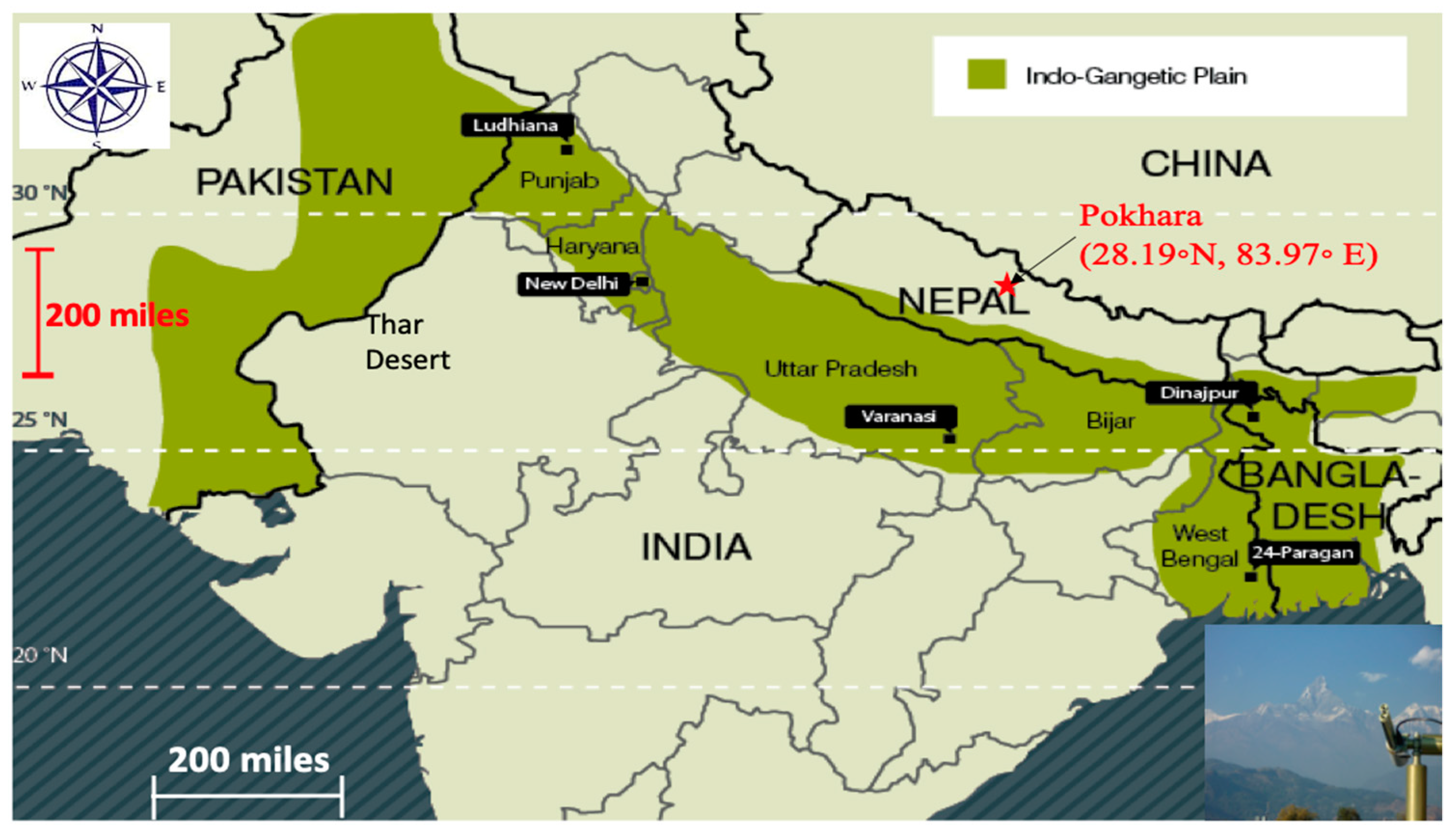
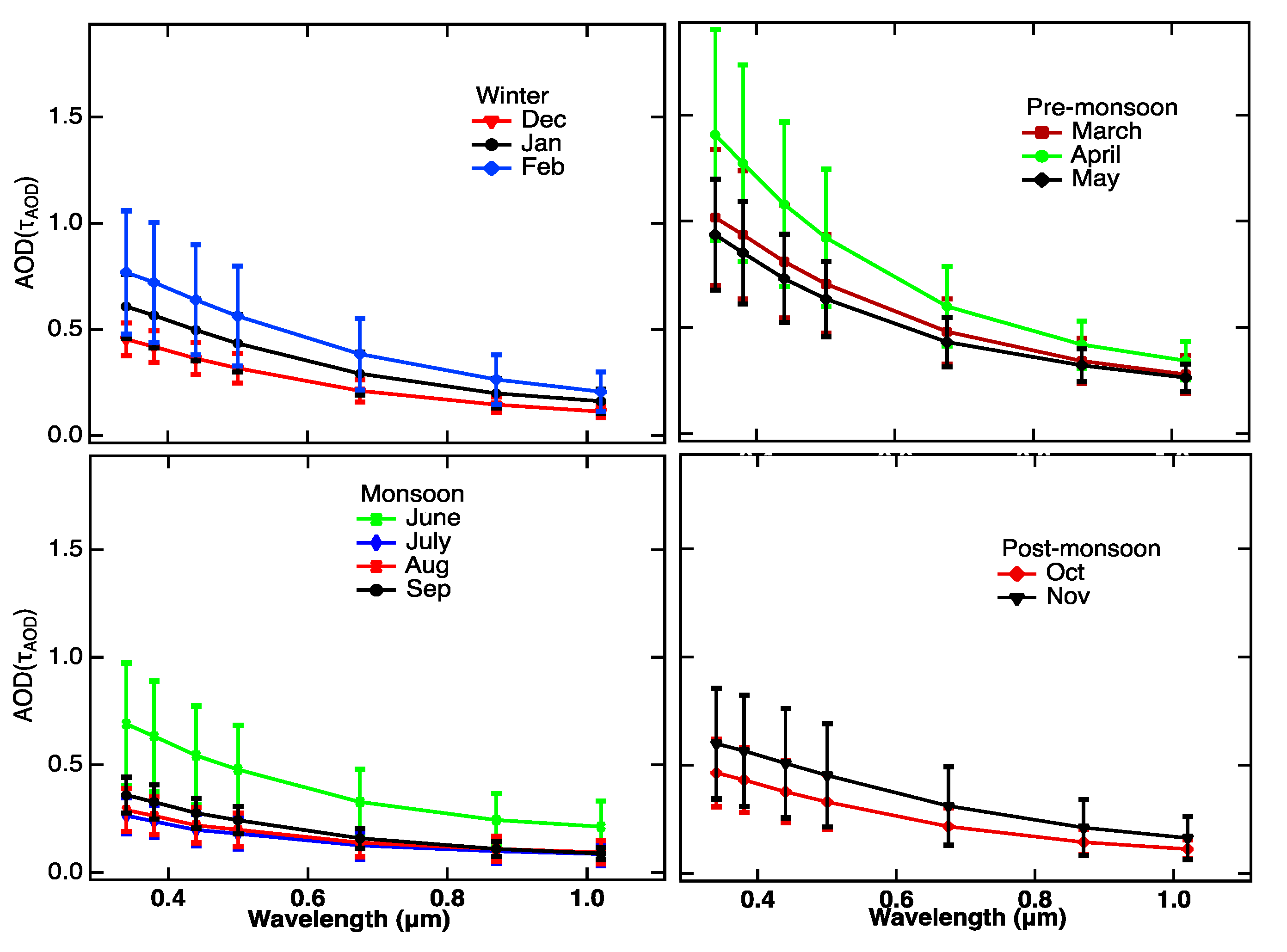
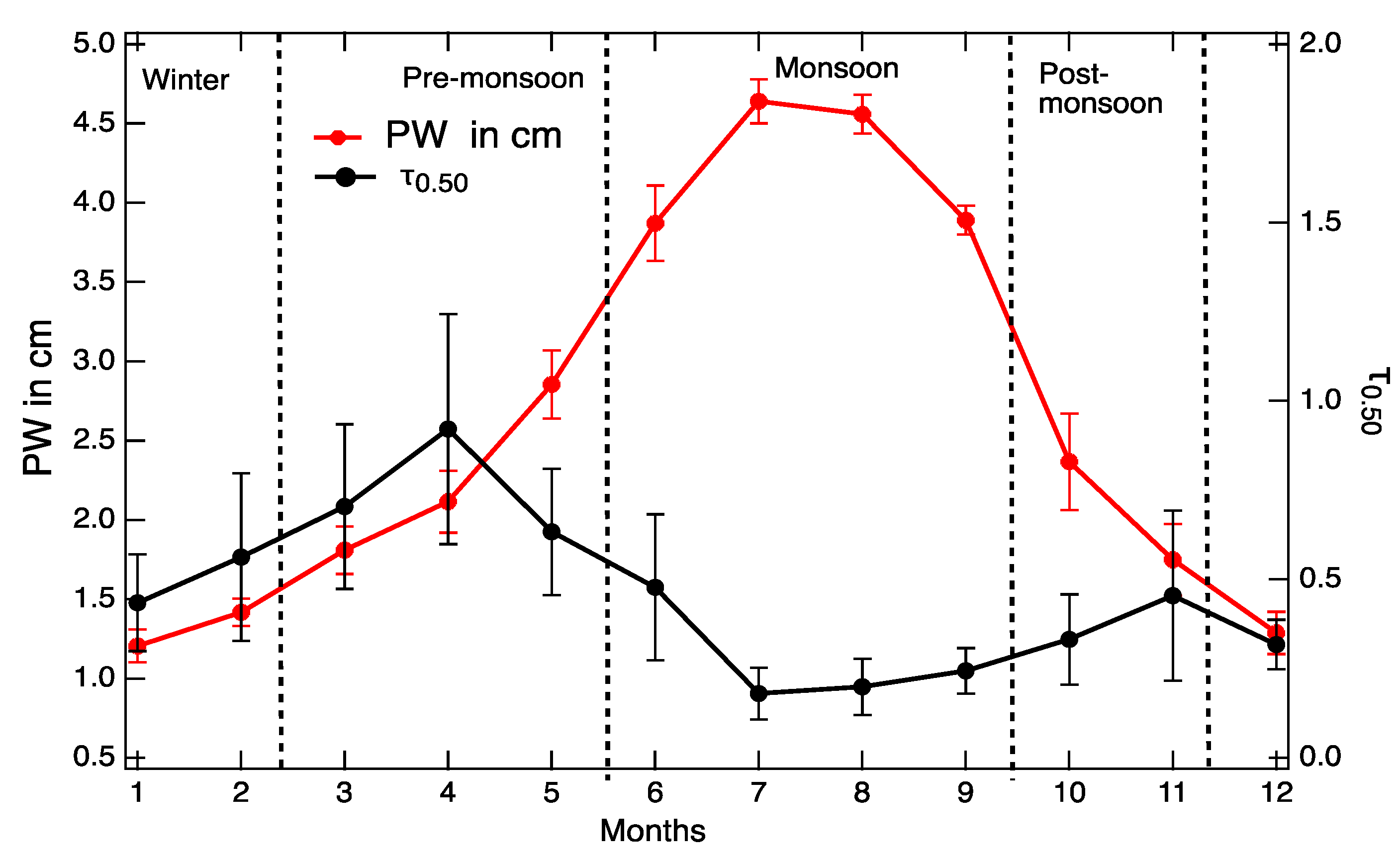
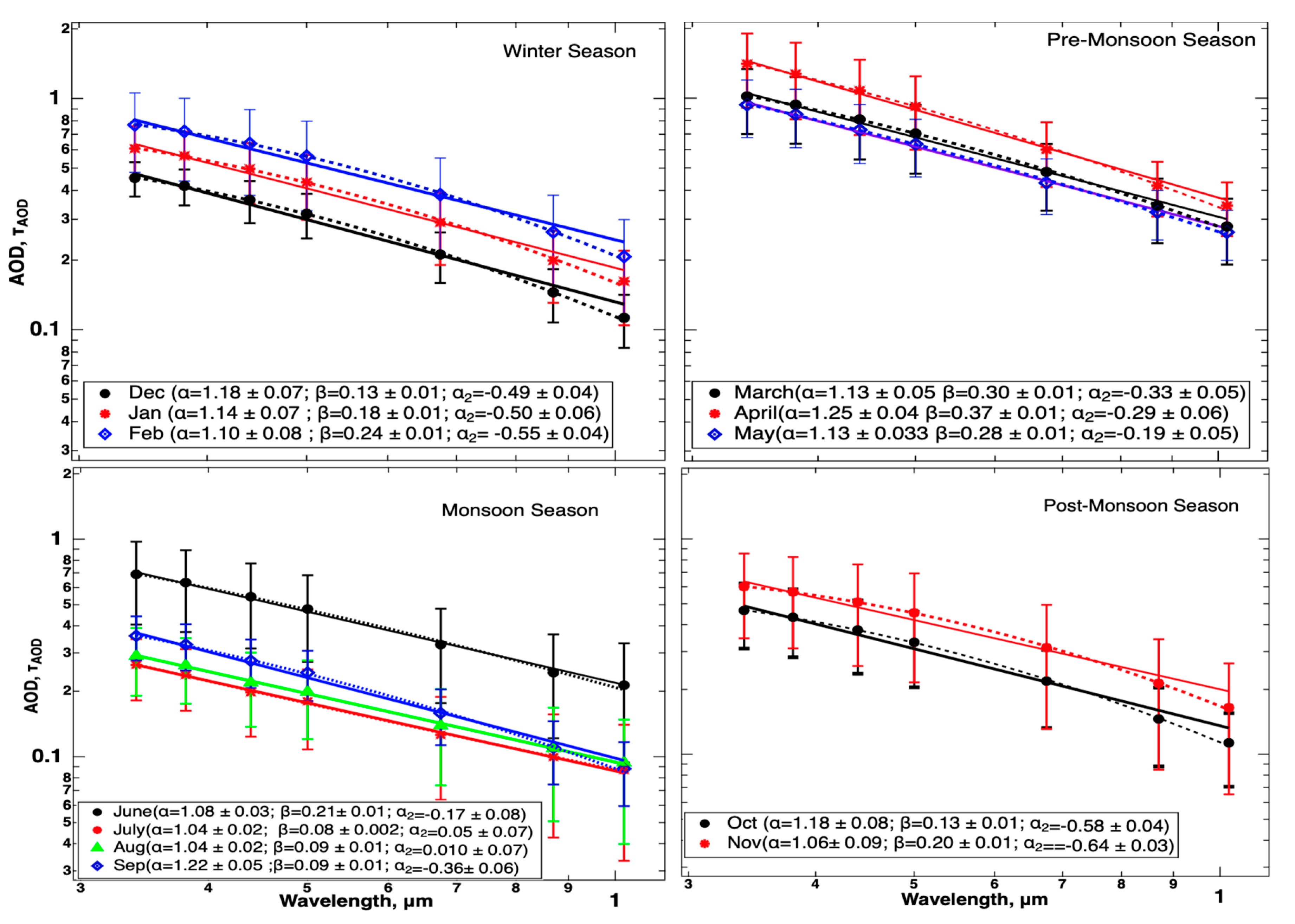

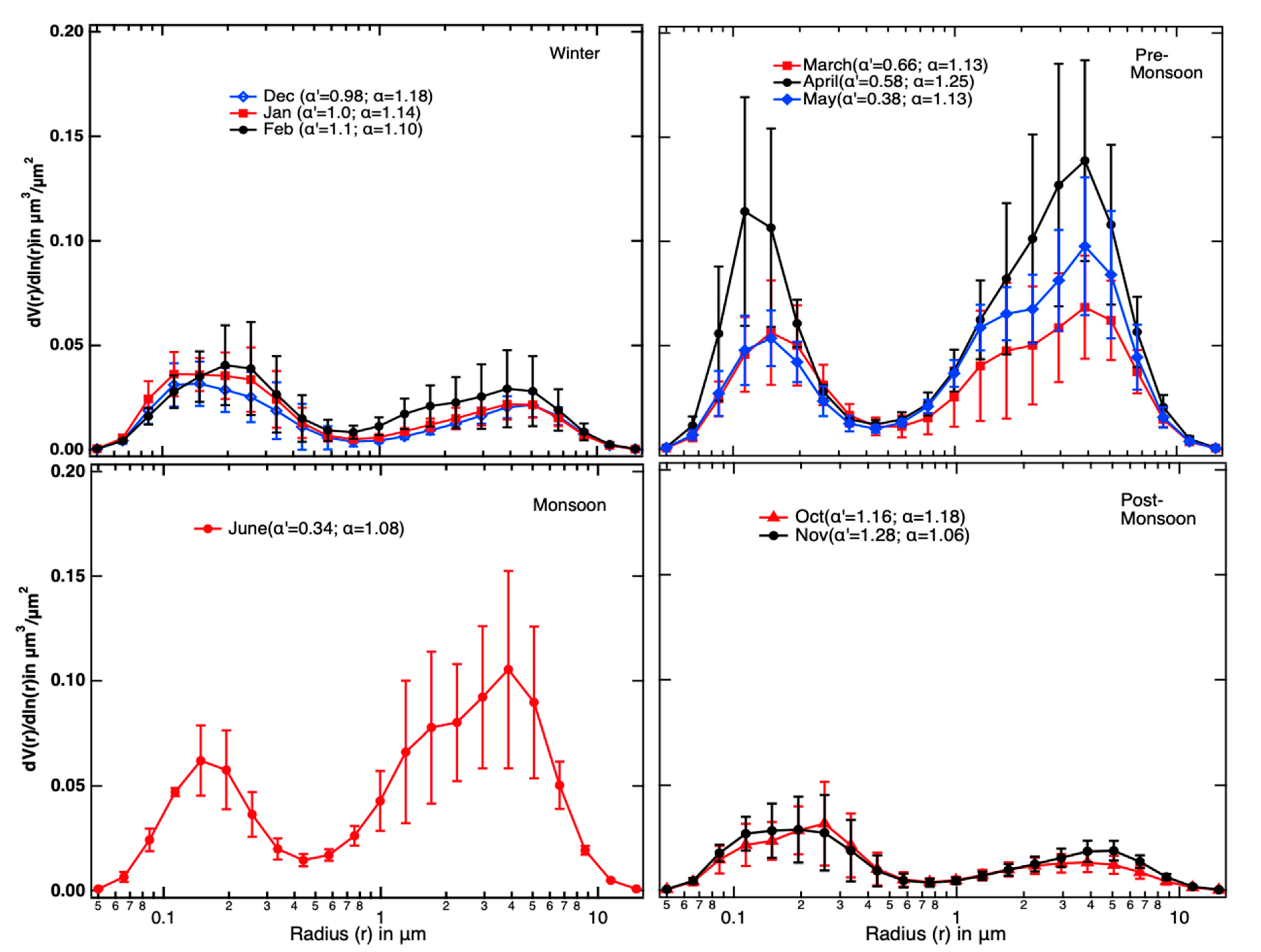
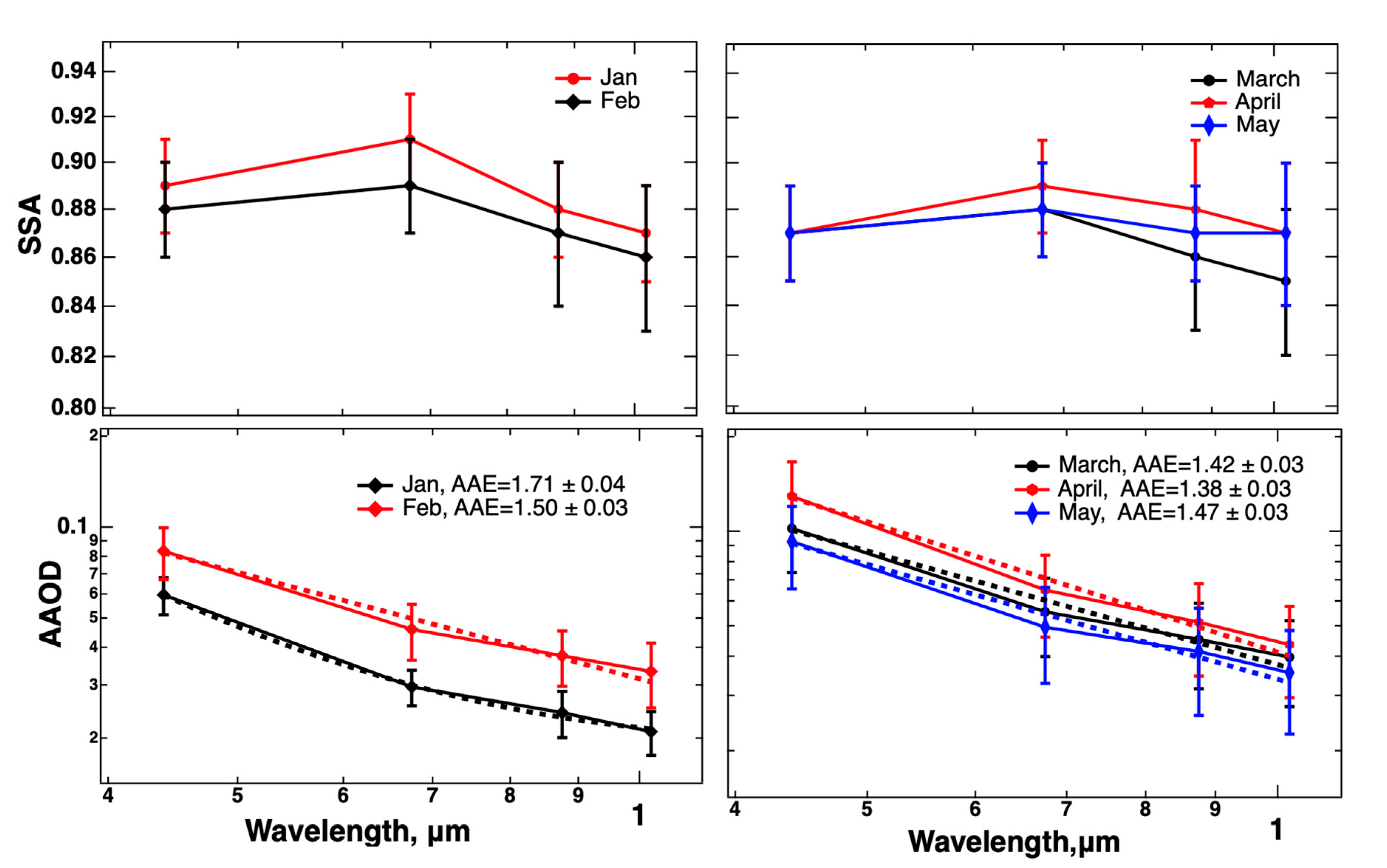

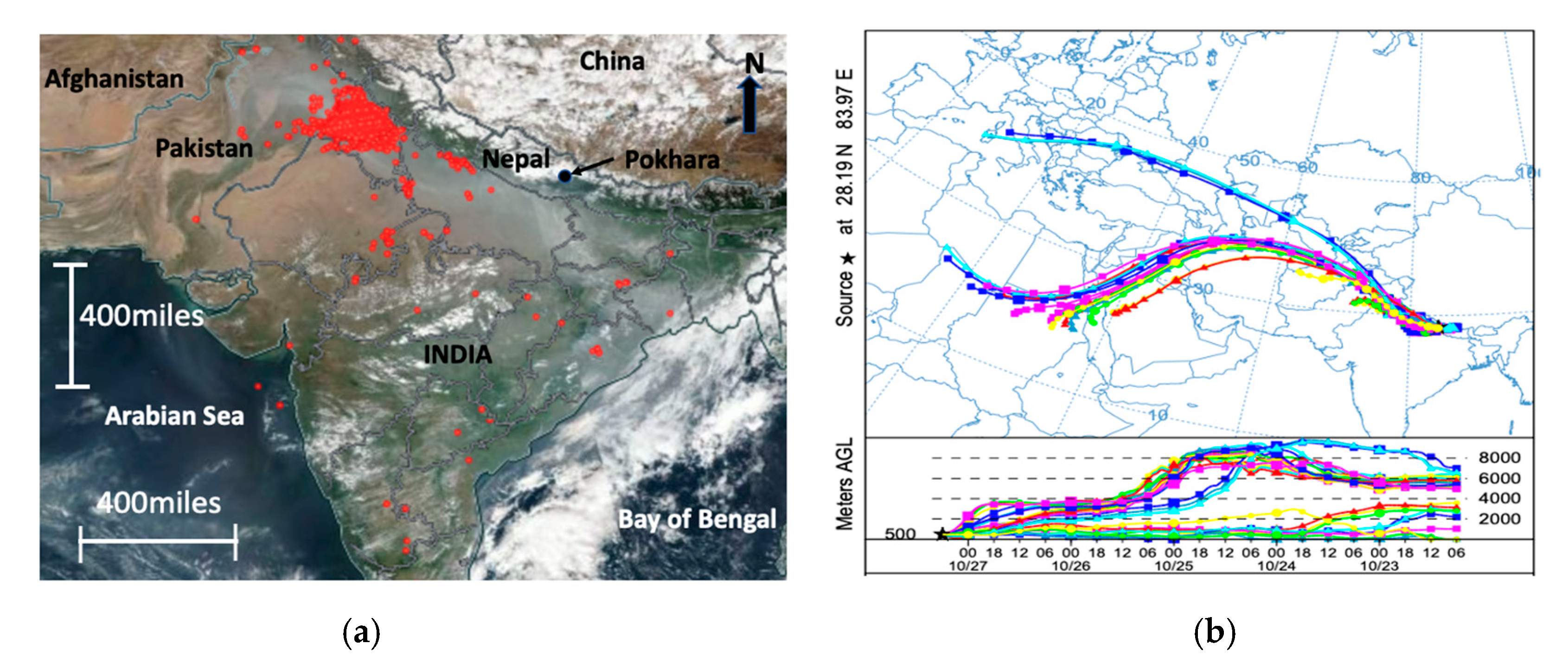
© 2020 by the authors. Licensee MDPI, Basel, Switzerland. This article is an open access article distributed under the terms and conditions of the Creative Commons Attribution (CC BY) license (http://creativecommons.org/licenses/by/4.0/).
Share and Cite
Regmi, J.; Poudyal, K.N.; Pokhrel, A.; Gyawali, M.; Tripathee, L.; Panday, A.; Barinelli, A.; Aryal, R. Investigation of Aerosol Climatology and Long-Range Transport of Aerosols over Pokhara, Nepal. Atmosphere 2020, 11, 874. https://doi.org/10.3390/atmos11080874
Regmi J, Poudyal KN, Pokhrel A, Gyawali M, Tripathee L, Panday A, Barinelli A, Aryal R. Investigation of Aerosol Climatology and Long-Range Transport of Aerosols over Pokhara, Nepal. Atmosphere. 2020; 11(8):874. https://doi.org/10.3390/atmos11080874
Chicago/Turabian StyleRegmi, Jeevan, Khem N Poudyal, Amod Pokhrel, Madhu Gyawali, Lekhendra Tripathee, Arnico Panday, Anthony Barinelli, and Rudra Aryal. 2020. "Investigation of Aerosol Climatology and Long-Range Transport of Aerosols over Pokhara, Nepal" Atmosphere 11, no. 8: 874. https://doi.org/10.3390/atmos11080874
APA StyleRegmi, J., Poudyal, K. N., Pokhrel, A., Gyawali, M., Tripathee, L., Panday, A., Barinelli, A., & Aryal, R. (2020). Investigation of Aerosol Climatology and Long-Range Transport of Aerosols over Pokhara, Nepal. Atmosphere, 11(8), 874. https://doi.org/10.3390/atmos11080874







